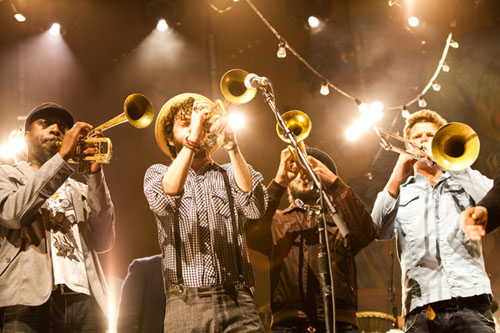 Back to selection
Back to selection
Five Questions with Big Easy Express Director Emmett Malloy

In Big Easy Express, director Emmett Malloy documents a tour by three cult-favorite indie-folk bands: Edward Sharpe and The Magnetic Zeros, Old Crow Medicine Show, and Mumford & Sons. But the free-wheeling travelogue that develops is equal parts itinerant jam, extended family picnic, and traveling carnival, with Malloy and his crew as the cinematic roustabouts getting it all down for posterity. The film follows the three bands from Oakland to New Orleans, giving us a glimpse not only of their concerts but of their camaraderie as they live and travel on a train together, sharing songs, time, and experiences, and ultimately becoming more like a troupe of old-time troubadours than a batch of independent acts.
The main precedent for Big Easy Express is the 2003 documentary Festival Express, about a similar 1970 train tour featuring The Band, The Grateful Dead, Janis Joplin, and others. Big Easy Express feels like the 21st century torch-carrier for the free spirit of music and friendship that earlier film focused on, with Malloy — previously a documentarian of everyone from Jack Johnson to The White Stripes — showing us that the freak flag of the open-hearted hippie era may be ripped and ragged, but it’s still out there flapping in the wind.
Big Easy Express plays AFI Silverdocs and the Los Angeles Film Festival this weekend, and is available on iTunes from June 26 and through BluRay and DVD on July 24.
Filmmaker: To what extent would you say your film is inspired by Festival Express?
Malloy: This film was made because of Festival Express. It was a huge influence, but more importantly the bands in that film were hugely influential to the three bands on this trip. Leading up to this film, I re-watched Festival Express and was really surprised at how little footage there was from that original journey, it was mostly comprised of interviews from the current time recounting what happened. So that gave us a lot of space to make our modern-day version with a new crew of bands. The bands played some incredible shows and I wanted to get that across dynamically, but I wanted to mainly make sure that the train was a lead character in this film. That is what made it unique to other tours.
Filmmaker: The train makes some extremely scenic stops in between concert destinations. To what extent was that predetermined for the film?
Malloy: I began my career as a director making surf films, and we always wanted to show people how interesting the process of traveling to find waves was — that the journey itself was just as compelling as the destination. That philosophy fit in perfectly for this film as well. The train took us through parts of our country that look the same as they did 100 years ago, and I wanted to make sure that our cameras told that story.
Filmmaker: What qualities do the three bands have in common that you strove to underscore in the film?
Malloy: In the film, the bands talk a lot about being “kindred spirits” and that really is the truth. These bands share a love for playing music that I have never witnessed. Each night the bands would play their show, in which all three bands would jump on and off stage continuously through their set and the other bands’ sets, then get on a train to play music until the sun came up. That theme of the “music never stopping” became the theme of my film. Also, they all don’t really ever shower.
Filmmaker: What was the personal dynamic between the bands during the trip? Were there some quirky personalities?
Malloy: The thing that struck me to be most unique about this film is that there were three bands, and each of them have quite a few members, and there was not one weird vibe or moment on this whole journey. I have worked with a lot of bands over the last decade, and most of the time a band of four or five people can’t get along very well on a given day. Being on a train was a real test because it was very tight quarters, and there was no avoiding anyone. You had to squeeze by everyone as you worked your way from one side to the other, so it seemed like the only choice was to just become friends. These bands will forever want to play music with one another and they all grew as musicians from being around one another. The quirkiest were Jade from Edward Sharpe and The Magnetic Zeros, Winston from Mumford, and all of Old Crow.
Filmmaker: What was your favorite scene that got left on the proverbial cutting-room floor?
Malloy: Easter morning we were rolling along somewhere near Mexico, and on this day I was really missing home. I think a lot of us were. Then out of nowhere, Ketch [Secor] from Old Crow’s dad came walking around saying there was going to be an Easter celebration in the band car. Suddenly the kids on the train started coloring Easter eggs and our mobile home sprang to life. All those interested packed into one car as Mr. Secor led us through an Easter vigil. Marcus Mumford and I gave readings and then we all joined in for sing-along of “Amazing Grace.” My crew filmed a bit of that morning, but when we got down to editing the film I felt that this moment was just for those who were there.

